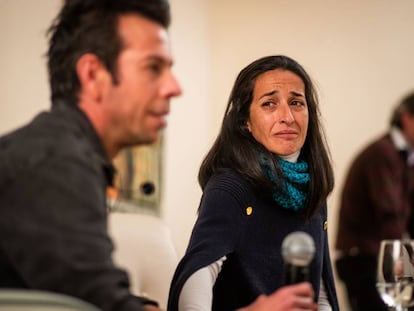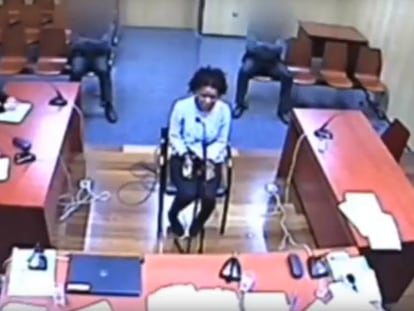How the Spanish justice system failed a mother and her two daughters
Itziar Prats’ children, Nerea and Martina, aged two and six, were murdered by their father after authorities failed to act on the report she filed against him
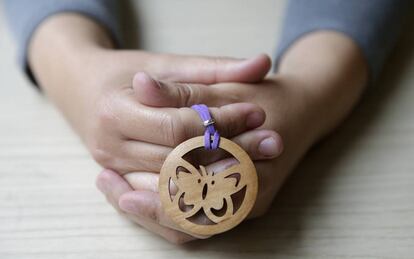
On September 25, 2018, Ricardo Carrascosa murdered his two daughters, aged two and six, in Castellón, a province in the eastern Spanish region of Valencia. After he killed them, he threw himself out of the window.
On that day, Itziar Prats, the 43-year-old mother of the two children, was woken up at 6am by a phone call from the police. They told her to come downstairs because they believed her ex-husband had committed suicide. Prats, still in pajamas, went outside with her mother and was asked to identify the body.
I reported him, and they told me that nothing would happen and now my daughters are no longer here Itziar Prats, 43, mother of the two girls
“They brought me to where he was to confirm that it was him. No one else could do it because he didn’t have any family there. [...] No one had any keys, and we had to call the firemen to open the door. [...] They told me to call out to see if girls would open the door because they knew my voice and would answer. The firemen banged down the door. [...] They didn’t let me through, so I stayed in the hall. I heard the medic saying ‘Don’t let her through, don’t let her through!’ and that’s when I realized that my girls were gone. I don’t know if I fainted, but the next thing I remember is being on the floor, supported by a policeman who took me out of there.”
Six months after the tragic event, Prats is seated on a park bench in central Madrid. After cremating the bodies of her two daughters, Nerea and Martina, and giving away most of their things, she moved back to the capital to live with her parents. She meets regularly with a psychiatrist and a psychologist. “I gave everything away. I didn’t want to hold onto things which would only make me suffer,” she explains. Prats regularly looks at pictures and videos of her two daughters in order to not forget their faces.
Prats and Carrascosa married in 2009, two years after moving to Castellón where he worked as a tile maker and she as a teacher in a center for minors. The couple lived far from their respective families – Prats’ family were in Madrid and Carrascosa’s in Villanueva del Arzobispo, a city in southern Spain. Prats decided to divorce him in 2017. “It was if he didn’t have a family. It was all about him. He complained that I didn’t pay attention to him and that I dedicated too much time to the girls,” she says.
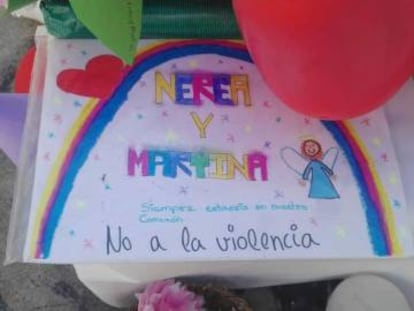
According to Prats, Carrascosa threatened to kill the girls multiple times. Her first complaint was filed on February 23, 2018, months after she started the divorce proceedings. That day the two were seated at a café in their neighborhood trying to figure out Carracosa’s visiting hours with the girls. Prats had custody of their daughters while Carracosa had limited access and had to pay €200 a month for each girl in child support. “You’ve ruined my life,” he said to Prats, warning her that she too would lose everything. Carrascosa later left with the girls because it was his weekend to be with them.
Prats was scared and went to the Women’s Center, which had been helping her since the beginning of the divorce process. “They told me that nothing would happen, that men say things but don’t do them. But I still went to the police station to report him.” She told police officers of Carrascosa’s “violent moments”, and his anger when he drank or when he broke things in the house.
After giving her statement, including details of the death threats made against the girls, her situation was classified as “low risk.” “The threats made against my daughters were not included in the [police] questionnaire. And of course, how are you going to measure something that is not registered?”
The police questionnaire, which determines the level of risk faced by gender violence victims, has been in use since 2007. Since then, it has undergone four modifications. The most recent one, which came into effect this year on March 13, includes specific instructions to assess the risk of murder to women and their children – a threat that had not previously been taken into account. For the 27 minors murdered before the protocol was introduced, including Nerea and Martina, the change came too late.
When Prats went to the police on February 23, she was not asked any questions about the risk that Carrascosa would murder his daughters, as she had warned. Prats left the police station at dawn after being told she would be notified when officers were going to arrest her ex-husband. “They told me to wait because they would first get the girls and then call me,” she says. She received no calls over the weekend.
They didn’t think the risk was big enough to take action Itziar Prats, 43, mother of the two girls
On Saturday, the day after filing the complaint, Prats approached the police court. “They told me as a police court they did not have the power to handle the situation. I went home and waited. On Sunday my mother, who came from Madrid, picked up the girls.”
Carrascosa was not arrested until Monday afternoon, three days after Prats filed the report. The police never informed her. Officers took Carrascosa’s statement and let him go.
Alongside the photos of her daughter, Prats saved recorded phone calls with her ex-husband in which he insulted and threatened her. She gave both the recordings and their transcriptions to the judge, who did not view them as relevant. “I reported him, and they told me that nothing would happen and now my daughters are no longer here,” says Prats. “They didn’t think the risk was big enough to take action.”
When asked why she thought no measure was taken, she explains, “The judge thought that I hadn’t sufficiently explained my fear or why I had gone to live 200 meters away from him. He didn’t ask me why I had done it or what I was scared of. I was never asked anything. Only if I confirmed the complaint.”
Prats explains she moved near to him "because I couldn’t find another apartment and I worked next door and the daycare center and school were nearby. His threats were not against me, they were against them.”
- Did someone examine your daughters?
- No, no one examined my daughters or Ricardo or me. They didn’t believe me.
- Did they ever review you before the Forensic Assessment Unit? [a court service conducted by specialists to help with cases]
- No. They didn’t ask for information from the Women’s Center even though they knew I was receiving treatment there. They didn’t ask for anything.
The case was dropped in May. The prosecutor and the judge ruled that there was no serious threat and a lawyer recommended that Prats withdraw her complaint. “I don’t think they considered many things, they didn’t care about what I told them. They don’t realize that they’re working with people. They do not care.”
Small gestures
After the tragic murder on September 25, Prats is trying to rebuild her life. “I’m doing better now. I try not to stay home. I get up, I get dressed and I go out. It’s necessary,” she says as she walks toward a coffee shop in Madrid. She goes to the gym and is studying, even though it’s very hard for her to concentrate. She likes to go on walks with her friends and family, and is very grateful for the support she receives from people back in Castellón. “I’ve had support from people who don’t even know me. They have found out [about the murder] and contacted me. They each try to put in their grain of sand so that I am better and this [case] is visible.”
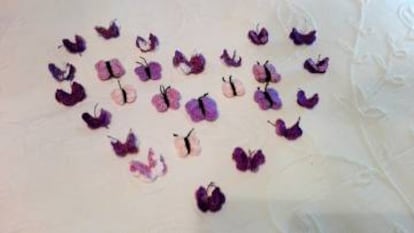
While she is comforted by the support, she prefers to remain anonymous, which is why she asks not to appear in photographs. “We are all capable of making a small gesture which drives change,” she says. A stranger once sent Prats a wooden butterfly in memory of the victims of gender violence, which she hopes will be sent to more places around the world to raise awareness. Since then, Prat’s mother has been weaving butterflies and her father has “been fighting” to make sure that “this does not happen again.”
English version by Asia London Palomba.
Tu suscripción se está usando en otro dispositivo
¿Quieres añadir otro usuario a tu suscripción?
Si continúas leyendo en este dispositivo, no se podrá leer en el otro.
FlechaTu suscripción se está usando en otro dispositivo y solo puedes acceder a EL PAÍS desde un dispositivo a la vez.
Si quieres compartir tu cuenta, cambia tu suscripción a la modalidad Premium, así podrás añadir otro usuario. Cada uno accederá con su propia cuenta de email, lo que os permitirá personalizar vuestra experiencia en EL PAÍS.
¿Tienes una suscripción de empresa? Accede aquí para contratar más cuentas.
En el caso de no saber quién está usando tu cuenta, te recomendamos cambiar tu contraseña aquí.
Si decides continuar compartiendo tu cuenta, este mensaje se mostrará en tu dispositivo y en el de la otra persona que está usando tu cuenta de forma indefinida, afectando a tu experiencia de lectura. Puedes consultar aquí los términos y condiciones de la suscripción digital.
More information
Archived In
Últimas noticias
Most viewed
- Alain Aspect, Nobel laureate in physics: ‘Einstein was so smart that he would have had to recognize quantum entanglement’
- Mexico’s missing people crisis casts a shadow over World Cup venue
- Why oil has been at the center of Venezuela-US conflicts for decades
- Trump clarifies who is ultimately in charge in Venezuela: ‘Me’
- Mexico seeks to shore up its defenses following US incursion in Venezuela

